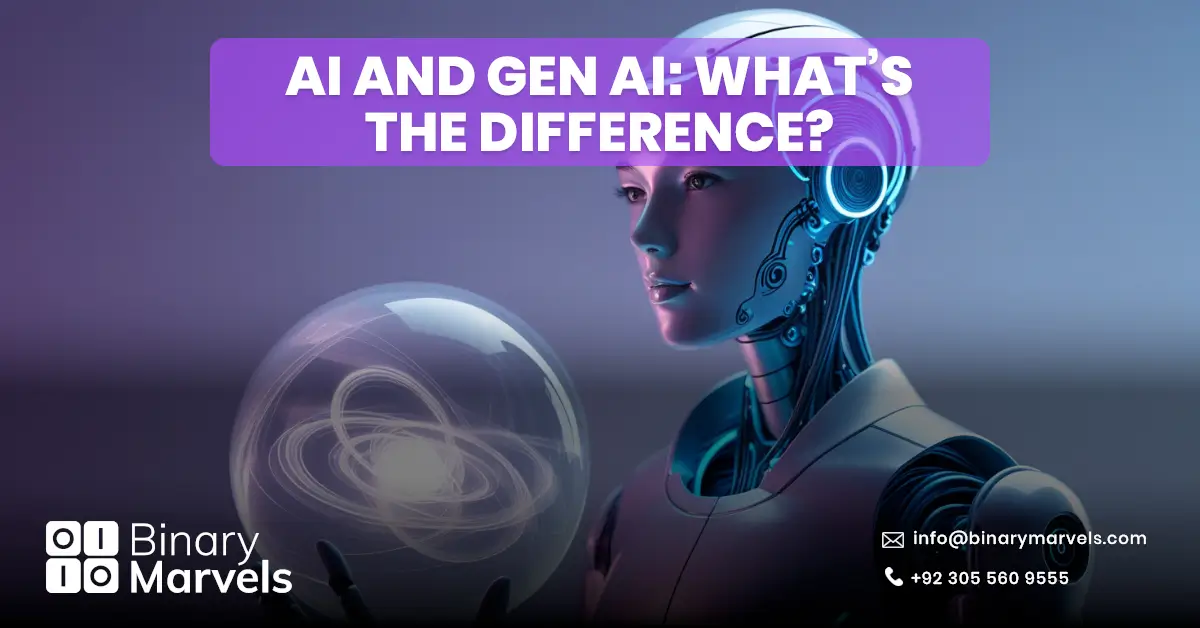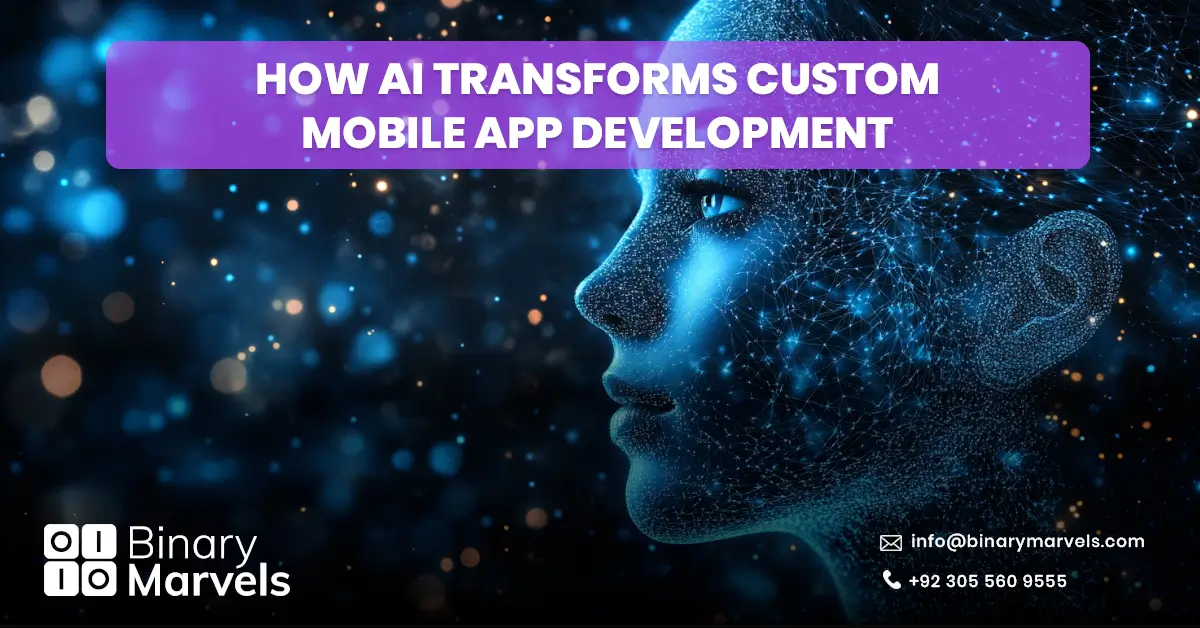
In recent years, artificial intelligence (AI) and Generative AI have emerged as transformative forces across various industries, revolutionizing how businesses operate and engage with customers. While both technologies are subsets of AI, they are not the same. Traditional AI and Generative AI serve distinct functions and offer unique benefits that can significantly impact business outcomes. Understanding the differences between the two is essential for businesses looking to leverage the right technology for their needs.
In this article, we will explore the fundamental concepts of AI and Generative AI, their benefits, real-world applications, and how they compare. Additionally, we will discuss how businesses can determine which technology is best suited for their objectives, and how Binary Marvels AI services can help you overcome business challenges.
Also Read: Top 10 AI Companies in Pakistan
What is Traditional AI?
Traditional AI, often referred to as narrow or weak AI, refers to systems designed to simulate human intelligence in specific, predefined tasks. These systems are typically built using algorithms that enable them to process large amounts of data, learn from patterns, and make decisions based on logical conclusions. While traditional AI is focused on performing specific tasks such as classification, prediction, or pattern recognition, it is not capable of general intelligence or creativity.
Key components of traditional AI include:
- Machine Learning (ML): Machine learning is a subset of AI where algorithms learn from data. It includes supervised learning, unsupervised learning, and reinforcement learning.
- Natural Language Processing (NLP): NLP enables machines to understand and interpret human language, allowing for applications like chatbots and voice assistants.
- Expert Systems: These systems use a knowledge base and inference rules to mimic decision-making abilities of human experts in specific domains.
Also Read: The Ultimate Guide to Implement AI Automation Services
5 Top Benefits of AI
AI has become indispensable for modern businesses because it delivers numerous advantages that enhance operational efficiency and provide valuable insights. Here are five top benefits of traditional AI:
- Increased Efficiency: AI automates routine tasks, which significantly reduces the time and effort required by human workers. For instance, AI-powered systems can handle customer inquiries, data entry, and even predictive maintenance without human intervention.
- Cost Savings: By automating processes and reducing human labor, AI helps businesses cut down on operational costs. This is especially valuable for businesses looking to optimize their resources and improve profitability.
- Improved Decision-Making: AI uses advanced algorithms to analyze massive datasets, uncover patterns, and make data-driven recommendations. This allows business leaders to make informed decisions based on real-time insights, which can lead to better outcomes.
- Personalization: AI enables businesses to deliver personalized experiences to customers. In retail, for example, AI can suggest products based on customer preferences, enhancing user satisfaction and driving sales.
- Predictive Analysis: AI’s predictive capabilities allow businesses to anticipate future trends, customer behaviors, and market demands. This can lead to more accurate forecasting, proactive strategies, and improved customer engagement.
What Are the Real-World Applications of AI?
AI is used in a broad range of industries, and its applications continue to grow. Let’s explore how AI is making an impact in different sectors:
- Healthcare: AI-powered diagnostic tools are improving patient care by enabling early detection of diseases such as cancer. AI can also assist doctors in analyzing medical images and recommending treatment options.
- Finance: In the financial industry, AI helps with fraud detection by identifying unusual patterns in transactions. AI algorithms are also used in stock trading to predict market movements and execute trades at optimal times.
- Retail: Retailers use AI to personalize shopping experiences, recommend products to customers, and optimize inventory management. AI is also used to predict demand and adjust pricing dynamically.
- Transportation: AI is crucial in developing autonomous vehicles and optimizing logistics. AI systems can predict traffic patterns and plan optimal routes for delivery trucks or self-driving cars.
- Manufacturing: AI enables predictive maintenance in manufacturing, identifying potential equipment failures before they occur. This helps reduce downtime and improve operational efficiency.
Also Check: How to Choose the Right AI Model for Your Application?
What is Generative AI?
Generative AI is a subset of artificial intelligence focused on creating new content rather than analyzing or processing existing data. Unlike traditional AI, which excels at classification and prediction tasks, Generative AI is designed to generate new outputs that resemble data patterns it has been trained on. This can include text, images, videos, music, and even 3D models.
Generative AI works by utilizing advanced machine learning techniques, most notably Generative Adversarial Networks (GANs) and Transformer models (like GPT). GANs use two neural networks—one to generate content and another to evaluate it—while Transformer models like GPT (Generative Pre-trained Transformers) create human-like text based on training data.
5 Top Benefits of Generative AI
Generative AI offers unique advantages that make it highly valuable for businesses in creative fields, marketing, and beyond. Below are five top benefits of Generative AI:
- Creative Content Generation: Generative AI enables businesses to produce original content at scale, such as articles, advertisements, product designs, and even videos. This is especially valuable in industries where content is king, such as marketing and entertainment.
- Automation of Creative Processes: Traditionally, content creation required significant time and human resources. Generative AI automates these processes, allowing businesses to produce high-quality content quickly and efficiently.
- Enhanced Personalization: Generative AI can be used to tailor content to individual customers’ preferences, improving user experience and engagement. For example, personalized emails, ads, or recommendations can be automatically generated based on customer behavior.
- Innovation: Generative AI encourages innovation by generating new ideas and solutions that humans may not have considered. This can be useful for product design, marketing campaigns, or exploring new business models.
- High-Quality Output: By learning from vast datasets, Generative AI produces content that is often indistinguishable from that created by humans. This ensures high quality and relevance in the content it generates.
What Are the Real-World Applications of Generative AI?
Generative AI is having a transformative impact on various industries. Below are some of the leading real-world applications of Generative AI:
- Entertainment and Media: Generative AI is used to create movies, video games, and music. AI-generated scripts, characters, and environments can accelerate production timelines and reduce costs.
- Marketing and Advertising: In marketing, Generative AI helps generate personalized content for advertisements, email campaigns, and social media posts. It can also be used to create dynamic ad creatives based on real-time data.
- Design and Fashion: Fashion designers use Generative AI to create new clothing styles, patterns, and textiles. Similarly, architects and product designers can use AI to generate innovative designs and prototypes.
- Healthcare: In the pharmaceutical industry, Generative AI can assist in drug discovery by generating novel molecular structures. It can also create synthetic medical data for research and training purposes.
- Gaming: Generative AI enables procedural content generation, such as the creation of game levels, characters, and entire worlds, providing a more dynamic and engaging gaming experience.
Also Check: 7 Top Open-Source LLMs for 2025
Difference Between AI and Generative AI: A Quick Comparison
To better understand the differences between AI and Generative AI, here’s a side-by-side comparison:
| Feature | Traditional AI | Generative AI |
| Primary Purpose | Analyze and process existing data | Generate new content based on learned data |
| Core Functionality | Decision-making, pattern recognition, automation | Content creation (text, images, videos, etc.) |
| Use Cases | Healthcare, finance, retail, logistics | Art, marketing, entertainment, design, gaming |
| Technologies | Machine Learning, NLP, Expert Systems | GANs, Transformers, Deep Learning |
| Output | Data analysis, predictions, classifications | Creative content, simulations, new ideas |
AI vs. Generative AI: Which Suits Your Business?
Choosing between AI and Generative AI largely depends on your business goals and the challenges you are looking to solve:
- Use Traditional AI if you need automation, data analysis, and decision support. This is ideal for industries like healthcare, finance, and manufacturing, where efficiency and accuracy are paramount.
- Use Generative AI if your business requires creative content generation, innovation, or enhanced personalization. Generative AI is perfect for industries like marketing, design, and entertainment, where creativity and uniqueness are key to success.
Also Read: How to Train AI for Effective Customer Service?
Overcome Your Business Challenges With Binary Marvels AI Services
Binary Marvels offers advanced AI development services tailored to meet the unique challenges of your business. Whether you are looking to automate operations with traditional AI or innovate with creative content through Generative AI, we can help you achieve your objectives.
Our services include:
- AI Consultation: Custom strategies for implementing AI in your business.
- Generative AI Solutions: Leverage AI for creative content generation, design, and innovation.
- AI Integration: Seamlessly integrate AI technologies into your existing operations to improve efficiency.
Also Check: 5 Top Generative AI Challenges and their Solutions
FAQs
What’s the main difference between AI and Generative AI?
Traditional AI focuses on analyzing and processing existing data, while Generative AI is focused on creating new, original content.
Can AI and Generative AI work together?
Yes, businesses can use AI for data analysis and decision-making, while Generative AI can be used to create innovative solutions and content based on the analyzed data.
How can my business benefit from Generative AI?
Generative AI can help businesses generate creative content, automate content creation processes, and offer personalized experiences to customers.
Is Generative AI expensive to implement?
While the initial investment may be high, the long-term benefits of increased creativity, automation, and innovation make Generative AI a valuable investment for businesses.
Conclusion
AI and Generative AI are powerful technologies that are transforming the way businesses operate and engage with customers. While traditional AI focuses on automation, data analysis, and decision-making, Generative AI enables creative content generation and innovation. Understanding the differences between these technologies and choosing the right one for your business will help you unlock new opportunities for growth and success.
By leveraging AI and Generative AI effectively, businesses can streamline operations, enhance customer experiences, and foster innovation. Whether you’re looking to automate tasks with traditional AI or explore new creative possibilities with Generative AI, the right solution is just around the corner.
Supercharge Your Business with AI Today!
As a trusted AI Development Company in Pakistan, we deliver cutting-edge AI Development Services designed to streamline your operations and enhance customer engagement.
Don’t wait—connect with us now and take your business to the next level!









